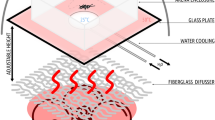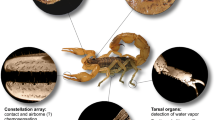Abstract
Homing ability of the cricket Gryllus campestriswas experimentally studied in the field after passive and active displacements. Whatever the weather conditions and the nature of the displacement, crickets (18/18) home directly when they are located between 5 and 15 cm from their burrow by performing real-time orientation. When moved by the experimenter between 15 and 55 cm away from home, some crickets (26/43) can retrieve their burrow by systematic searching only after winding inward trips but they get lost (0/18) beyond 55 cm. After self-generated movements between 5 and 85 cm away from home, crickets (33/35) return to their burrow under blue sky, but they cannot home as well under overcast sky (22/34 from 5 to 65 cm and 0/5 beyond). The volatile memory orientation system allowing path integration is based on the polarized skylight of the sun.
Similar content being viewed by others
References
Able, K. P. (1980). Mechanisms of orientation, navigation and homing. In Gauthreaux, S., Jr. (ed.),Animal Migration, Orientation and Navigation, Academic Press, New York, XII, pp. 283–373.
Batschelet, E. (1981).Circular Statistics in Biology, Academic Press, New York.
Beugnon, G. (1980). Daily migrations of the wood-cricketNemobius sylvestris (Bosc).Environ. Entomol. 9: 801–805.
Beugnon, G. (1983). Terrestrial and celestial cues in the visual orientation ofNemobius sylvestris (Bosc).Biol. Behav. 8: 159–169.
Beugnon, G. (1985). Orientation of evasive swimming inPteronemobius heydeni (Orthoptera: Gryllidae: Nemobiinae).Acta Oecol. Oecol. Gen. 6: 235–242.
Beugnon, G. (1986a). Spatial orientation memories. In Beugnon, G. (ed.),Orientation in Space, Privat, I.E.C., Toulouse, pp. 97–104.
Beugnon, G. (1986b). Learned orientation in landward swimming in the cricketPteronemobius lineolatus. Behav. Proc.12: 215–226.
Beugnon, G., Mieulet, F., and Campan, R. (1983). Ontogenèse de certains aspects de l'orientation visuelle du grillon des bois dans son milieu naturel.Behav. Proc. 8: 73–86.
Brunner, D., and Labhart, T. (1987). Behavioural evidence for polarization vision in crickets.Physiol. Entomol. 12: 1–10.
Burghause, F. (1979). Die strukturelle spezialisierung des dorsalen Augenteils der Grillen (Orthoptera, Grylloidae).Zool. Jb. Physiol. 83: 502–525.
Campan, R., and Gautier, J. Y. (1975). Orientation of the cricketNemobius sylvestris towards forest-trees. Daily variations and ontogenetic development.Anim. Behav. 23: 640–649.
Campan, R., Beugnon, G., and Lambin, M. (1987). Ontogenetic construction of behavior: The cricket visual world.Adv. Study Behav. 17: 165–212.
Cartwright, B. A., and Collett, T. S. (1983). Landmark learning in bees. Experiments and models.J. Comp. Physiol. 151: 521–543.
Cartwright, B. A., and Collett, T. S. (1987). Landmark maps for honeybees.Biol. Cybernet. 57: 85–93.
Etienne, A. S., Maurer, R., Portenier, V., Saucy, F., and Teroni, E. (1986). Short distance homing of the golden Hamster under conditions of darkness and light. In Beugnon, G. (ed.),Orientation in Space, Privat, I.E.C., Toulouse, pp. 33–44.
Fent, K., and Wehner, R. (1985). Ocelli: A celestial compass in the desert antCataglyphis.Science 228: 192–194.
Ferguson, D. E. (1967). Sun-compass orientation in Anurans. In Storm, R. M. (ed.),Animal Orientation and Navigation, Oregon State University Press, pp. 21–32.
Frantsevich, L., Govardovski, V., Gribakin, F., Nikolajev, G., Pichka, V., Polanovsky, A., Shevchenko, V., and Zolotov, V. (1977). Astroorientation inLethrus (Coleoptera, Scarabidae).J. Comp. Physiol. 121:253–271.
Görner, P., and Claas, B. (1985). Homing behavior and orientation in the funnel-web spider,Agelena labyrinthica Clerck. In Barth, F. G. (ed.),Neurobiology of Arachnids, Springer-Verlag, Berlin, Heidelberg, New York, pp. 275–297.
Gould, J. L. (1986). The locale map of honey bees: Do honey bees have cognitive maps?Science 232: 861–863.
Hoffmann, G. (1984). Homing by systematic search. In Varjù, D., and Schnitzler, H.-U. (eds.),Localization and Orientation in Biology and Engineering, Springer-Verlag, Berlin, Heidelberg, New York, pp. 192–199.
Hoffmann, G. (1985). The influence of landmarks on the systematic search behaviour of the desert isopodHemilepistus reaumuri. II. Problems with similar landmarks and their solution.Behav. Ecol. Sociobiol. 17: 335–348.
Labhart, T., Hodel, B., and Valenzuela, I. (1984). The physiology of the cricket's compound eye with particular reference to the anatomically specialized dorsal rim area.J. Comp. Physiol. A 155: 289–296.
Mieulet, F. (1980). Etude de la variabilité des modes d'orientation chez le grillon des boisNemobius sylvestris selon des biotopes différents. Thèse de 3ème cycle, Université Paul Sabatier, Toulouse.
Mittelstaedt, H. (1985). Analytical cybernetics of spider navigation. In Barth, F. G. (ed.),Neurobiology of Arachnids, Springer-Verlag, Berlin, Heidelberg, New York, pp. 298–316.
Mittelstaedt, H., and Mittelstaedt, M.-L. (1982). Homing by path integration. In Papi, F., and H. Wallraff, (eds.),Avian Navigation, Springer-Verlag, Berlin, Heidelberg, New York, pp. 291–297.
Mittelstaedt, M.-L., Mittelstaedt, H., and Mohren, W. (1979). Interaction of gravity and idiothetic course control in millipedes.J. Comp. Physiol. 133: 267–281.
Morvan, R., Campan, R., and Thon, B. (1977). Etude de la répartition du grillon des boisNemobius sylvestris dans un habitat naturel.Les larves. Terre Vie 31: 637–659.
Morvan, R., Campan, R., and Thon, B. (1978). Etude de la répartition du grillon des boisNemobius sylvestris dans un habitat naturel. Les adultes.Terre Vie 32: 611–636.
Papi, F., and Tongiorgi, P. (1953). Innate and learned components in the astronomical orientation of wolf-spiders.Ergebn. Biol. 26: 259–280.
Pardi, L., and Papi, F. (1952). Die sonne als kompas beiTalitrus saltator Montagu (Amphipoda, Talitridae).Naturwissenschaften 39: 835–842.
Rosengren, R., and Fortelius, W. (1986). Ortstreue in foraging ants of the Formica rufa group-Hierarchy of orienting cues and long-term memory.Insect. Soc. 33: 306–337.
Scapini, F. (1986). Inheritance of solar direction finding in sandhoppers. 4. Variation in the accuracy of orientation with age.Monitore Zool. Ital. 20: 53–61.
Schmidt-Koenig, K. (1975).Migration and Homing in Animals, Springer-Verlag, Berlin, Heidelberg, New York, p. 99.
Schmidt-Koenig, K., and Keeton, W. T. (eds.) (1978).Animal Migration, Navigation, and Homing, Springer-Verlag, Berlin, Heidelberg, New York, p. 462.
Schöne, H. (1984).Spatial Orientation. The Spatial Control of Behavior in Animals and Man, Princeton University Press, Princeton, N.J., p. 347.
Ugolini, A. (1986). Homing in femalePolistes gallicus (L.) (Hymenoptera, Vespidae) In Beugnon, G. (ed.),Orientation in Space, Privat, I.E.C., Toulouse, pp. 57–62.
Wehner, R. (1981). Spatial vision in Arthropods. In Autrum, H. (ed.),Handbook of Sensory Physiology, VII/6C, Springer-Verlag, Berlin, Heidelberg, New York, pp. 287–616.
Wehner, R. (1983). Celestial and terrestrial navigation: Human strategies—Insect strategies. In Huber, F., and Markl, H. (eds.),Neuroethology and Behavioral Physiology, Springer-Verlag, Berlin, Heidelberg, New York, pp. 366–381.
Wehner, R., and Wehner, S. (1986). Path integration in desert ants. Approaching a long-standing puzzle in insect navigation.Monitore Zool. Ital. 20: 309–331.
Author information
Authors and Affiliations
Rights and permissions
About this article
Cite this article
Beugnon, G., Campan, R. Homing in the field cricket,Gryllus campestris . J Insect Behav 2, 187–198 (1989). https://doi.org/10.1007/BF01053291
Accepted:
Issue Date:
DOI: https://doi.org/10.1007/BF01053291




